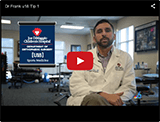What is a Physician Assistant?
Physician Assistance Medicine is the practice of medicine by a qualified physician assistant or PA who provides health care under the supervision of an orthopedic surgeon. The chief activities of a physician assistant include performing services related to diagnosis, therapy, prevention, and health maintenance.
Physician assistants are educated and trained health care professionals, who do the traditional tasks of a physician, but work under the assistance of a physician as part of a health care team. In the physician-physician assistant relationship, physician assistants’ exercise autonomy in decision making and provide a broad range of diagnostic and therapeutic management services. A physician assistant’s practice may also include education, research, and administrative services.
Physician assistants work in all areas of medicine, including primary care and specialized areas such as orthopedics, gynecology, and psychiatry etc. A physician assistant may close incisions and provide care during, before and after a surgical procedure.
A physician assistant’s duties include the following:
- Working under the supervision of a physician or surgeon
- Reviewing patients’ medical histories
- Doing physical exams to check patients’ health
- Ordering and interpreting diagnostic tests, such as X-rays or blood tests
- Making preliminary diagnosis about a patient’s injury or illness
- Providing treatment, such as setting broken bones and giving immunizations
- Providing preventive health care to patients
- Counseling patients and their families about disease, medication and lifestyle changes
- Assisting the physician during surgery
- Recording and assessing patient progress
- Assisting with insurance paperwork
-
Personalized Physical Therapy Puts Bryant Back on the Court
Bryant could hear the whistles blowing as he walked by the gymnasium.
View more -
No off-season for sports injuries
As a new season of school sports and youth leagues gets underway,
View more -
Student Athletes Benefit from Individualized Treatment at U18 Sports Medicine
Becoming involved in a sport is one of the healthiest things that a child can do.
View more -
For young athletes, injuries need special care
More programs are using procedures and surgical techniques tailored for kids.
View more -
Dr Frank u18 Tip 1
 View more
View more -
Segment U18 Tip with Dr Frank 1
 View more
View more -
Dr. Frank’s 2010 WQAM high school football game halftime interviews
View more




 Menu
Menu






 In The News
In The News Hollywood Office
Hollywood Office

![[U18] Sports Medicine](https://www.kidbones.net/wp-content/themes/ypo-theme/images/u18-sports-medicine-performing-arts-logo.png)












